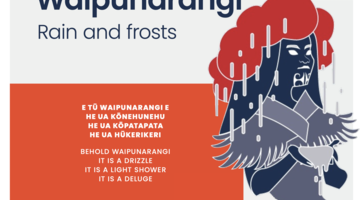While climate change will impact us all, it poses significant physical and cultural challenges for Māori. Shaun Awatere, mātauranga Māori advisor for Our atmosphere and climate 2020, explains a few of them.
Questions for discussion:
- What is one of the physical impacts climate change may have on whenua?
- How might the narratives of wāhi tapu and wāhi hītori be lost if the physical sites disappear?
Transcript
DR SHAUN AWATERE
Climate change has a number of impacts that are going to affect life as we know it for iwi and hapū into the future. From the physical impacts to whenua, with respect to the ability to grow diverse crops, to the impact of flooding on people’s homes, on the ability to gather for tangi and social activities. Some potential impacts that climate change may have on marae, particularly if they are in low-lying areas or on the floodplains, is flood damage. So communities, iwi and hapū will have to engage in those very hard discussions around the relocation of those marae into the areas which are going to be able to adapt to those impacts of sea level rise, coastal erosion and the increasing intensity of storms.
Particular areas have incredible significance. Some have stories contained with them that talk about the arrival of people to those areas and associate people to place. With the impacts of climate change, there is the danger that those types of narratives may be lost as those physical areas are washed out to sea.
An additional impact of climate change is going to be on the retention of mātauranga Māori. One example of an implied practice of mātauranga Maori is using the maramataka – the Māori lunar calendar. It was a tool that was able to utilise all of this knowledge that Māori had gained over a number of years through their close association with the natural environment to make informed observations about what were the best seasons, what were the best times and what were the best days to go out and harvest, to use natural resources like tuna, like ducks and other things that were useful for helping people to survive.
Acknowledgements
Dr Shaun Awatere, Manaaki Whenua – Landcare Research
Waimarie McFarland of Te Pane O Mataoho and Nicola Kawana planting kumara with traditional tools. Whānau Living, Adrenalin Group
Ngāti Hauā Mahi Trust plant nursery, University of Waikato and Waikato Regional Council
Manuhiri walking onto marae and wharekai footage, with permission of Para Kore. Copyright Ministry for the Environment
Flooding and storm footage, NIWA
Aerial view of land with low cloud, Waikato Regional Council
Maramataka dial, courtesy of Ayla Hoeta and Matua Rereata Makiha. Sourced from The Spinoff
Kina and harvesting kina, Matty P, Earthly Eats
Acknowledgement
This resource has been produced with the support of the Ministry for the Environment and Stats NZ. (c) Crown Copyright.




